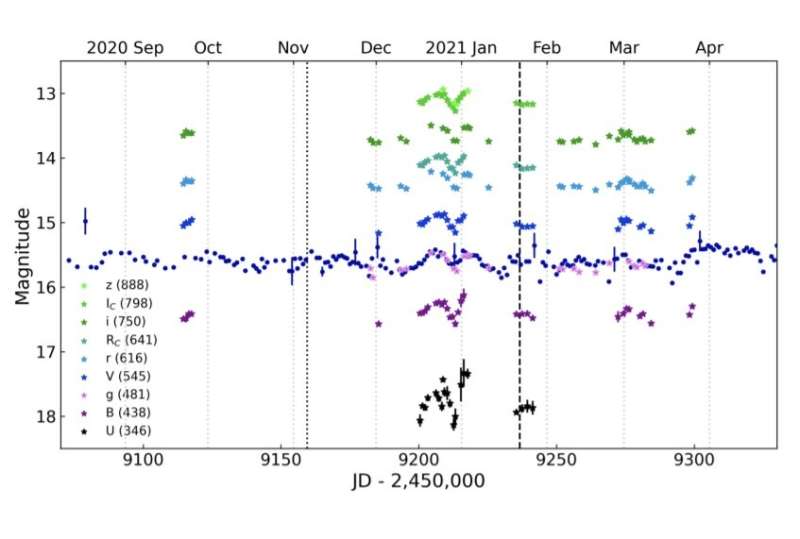Research inspects a peculiar eruptive young star

An international team of astronomers has performed photometric and spectroscopic observations of a peculiar eruptive young star known as V899 Mon. Results of the observational campaign shed more light on the nature of this star. The research was detailed in a paper published September 23 on arXiv.org.
Located some 2,600 light years away near the Monoceros R2 molecular cloud, V899 Mon (also known as IRAS 06068-0641) is an eruptive young stellar object (YSO). The star is estimated to be about two times more massive than the sun and its radius is most likely between four and six solar radii.
Previous observations have shown that V899 Mon has experienced a very bright outburst that started in November 2009 and reached its peak brightness in 2010. Afterward, it went back to quiescence for a relatively short period in 2011 and brightened again in 2012. However, the observations conducted during the bursting period of V899 Mon have not provided enough data to get further insights into the nature of this object.
In general, YSOs are classified as FU Orionis-type objects (FUors) or EX Lupi-type objects (EXors). FUors brighten by more than magnitude 4 in the optical domain and remain in their brightened state for several decades. EXors also brighten by a few magnitude, but unlike FUors, they remain in the high brightness stage for a few months to a few years. In the case of V899 Mon, its classification is still uncertain.
Therefore, a group of astronomers led by Sunkyung Park of Konkoly Observatory in Budapest, Hungary, multifilter optical photometric monitoring, as well as optical and near-infrared spectroscopic observations of V899 Mon in order to find out whether this YSO is a FUor or an EXor, and to learn more about its properties.
The observations found that the second peak of the outburst of V899 Mon occurred in 2018. Since then, the brightness of the star has gradually decreased with an approximate rate of 0.30 mag per year. The most dramatically strong burst occurred in the 2017–2018 season, and it lasted for about 200 days. Then, again, a shorter and weaker accretion burst was observed in the 2020/2021 season.
The astronomers noted that the increasing number of accretion bursts in V899 Mon in parallel with the disk brightness decrease suggests that the YSO is gradually switching from the still not well-understood accretion mechanism during the enhanced accretion to the magnetospheric accretion mechanism.
The study found that in the case of V899 Mon, the small amplitude of photometric variations, rich emission lines, measured mass accretion rate, and mass loss rate show similar properties to those of classical T Tauri-type stars (CTTS). Furthermore, the gradual decreasing of V899 Mon suggests that it is almost finishing its second outburst, and is now on the way back to the quiescent phase.
Taking into account all the results, the researchers assume that V899 Mon is most likely of the EXor type.
“Our recent photometric and spectroscopic observations of V899 Mon in the current evolutionary stage show more features typical for EXors,” the authors of the paper concluded.
ASASSN-18aan is an unusual cataclysmic variable, study finds
Sunkyung Park et al, V899 Mon: a peculiar eruptive young star close to the end of its outburst. arXiv:2109.11283v1 [astro-ph.SR]. arxiv.org/abs/2109.11283
© 2021 Science X Network
Citation:
Research inspects a peculiar eruptive young star (2021, September 29)
retrieved 29 September 2021
from https://phys.org/news/2021-09-peculiar-eruptive-young-star.html
This document is subject to copyright. Apart from any fair dealing for the purpose of private study or research, no
part may be reproduced without the written permission. The content is provided for information purposes only.
For all the latest Science News Click Here
For the latest news and updates, follow us on Google News.

